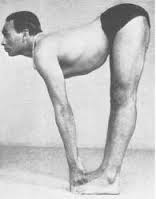Today was a nice day to reclaim part of my practice as I have been subbing heavily for my mentoring teachers who are teaching in China. During my own teacher training years ago, my mentoring teacher Ray said that a teacher gives up part of his practice for his students. I understand how true that is as time studying to prepare for weekly classes cuts into one’s one personal sadhana. But that is the sadhana of a teacher.
This is “backbend week” (save Tuesday’s forward bend sequence for International Yoga Day), and I am working on a sequence and modifications for one of my students who has a wrist injury and another student who gets severe headaches after backends. I am grateful for Guruji’s innovations to accommodate injuries and medical conditions of all kinds.
Because of the body I have been given, backbends come fairly easily for me. It has been a blessing as I see how other struggle with this clan of poses. Because of that, I don’t practice backbends as often as other clans which I truly struggle with–namely twisting poses.
But today I cut loose and did a few cycles of Urdvha Dhanurasana at the wall. I am nursing a shoulder injury which I attribute to my sedentary desk job and hours of driving. Today, my shoulder cooperated and and gave me the freedom to push up into the classic pose.
I have heard that injuries are a blessing for a teacher as they make one think of how to practice around it and then utilize actions that benefit and heal it. That gives much potency to one’s teaching to another student who has a similar injury. My left shoulder struggles in Gomukhasana due to a pinched nerve. But the more I work on other actions, the Gomukhasna eventually comes.
When one delves into the deeper yogic philosophy, we see that we have many sheaths of our being and that the physical body is only part of it. I find it a bit humorous that it is referred to as the “food” layer (annamayakosa) and is the most transient layer of who we really are. It is always changing.
Home practice is a charming endeavor. In between poses, my wife calls and asks me to find some cabinet clips. Being a husband is my first duty, so I help. Then back to practice. I read a few pages of Light On Yoga here, google a few photos there, then try something new. I fail, then re-check the picture, then redo. It is like doing homework with your own body.
Home practice feels comfortable and satisfying. I am now grounded and recharged for the hectic week ahead…








































